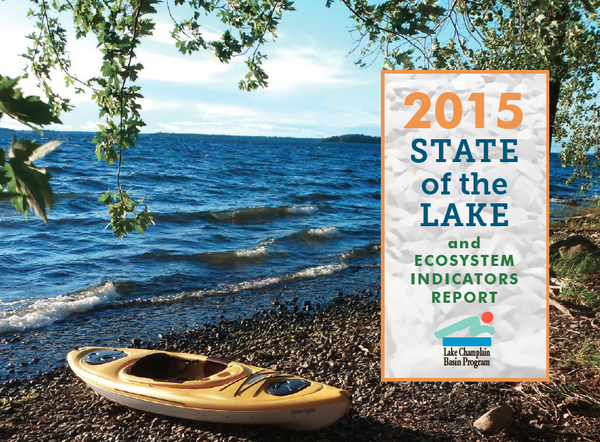The Lake Champlain Basin Program released their 2015 State of the Lake report on June 30. The report states that, “although water quality trends in Lake Champlain are cause for concern. . .more than 85% of Lake Champlain’s water is consistently of excellent quality and another 13% of the water is usually in quite good condition. In the remaining 2% of the Lake, conditions are seasonally alarming. The most compromised parts of the Lake are St. Albans and Missisquoi Bays … and the South Lake”.
The State of the Lake report offers information about lake conditions related to phosphorus, beach closures, fish consumption advisories, invasive species, and climate change. It updates the last such report which was issued in 2012. A two-page central spread condenses the information down to nine key indicators and provides information about status and trends of each indicator for each of the five major lake segments: Missisquoi Bay, the Northeast Arm, Mallets Bay, the Main Lake, and the South Lake. The indicators offer a mixed review of how well the lake is doing. “Phosphorus concentrations have not decreased significantly in any areas of Lake Champlain, despite reductions in the amount of phosphorus entering the Lake from several of its tributaries. Long-term trends since 1990 indicate that phosphorus concentrations in several segments continue to increase.” The report cites no trend in in-lake phosphorus concentrations for four lake segments, while concentrations are increasing in the Northeast Arm. Three lake segments show declines in annual nonpoint source loading, there are increases in Mallets Bay and no trend for the Northeast Arm. There have been more beach closures in the Main Lake, fewer in the Northeast Arm, no change in Mallets Bay, and insufficient information for Missisquoi Bay and the South Lake. There is no change in trends for blue-green algae blooms for three lake segments but more blooms in the Northeast Arm and Main Lake. Sea lamprey wounding rates have decreased in all lake segments.
The Basin Program’s next major task will be updating Opportunities for Action, the plan for coordinating and directing the actions of federal and state partners to improve and manage the state of the lake. You can read the report online or download a PDF.
